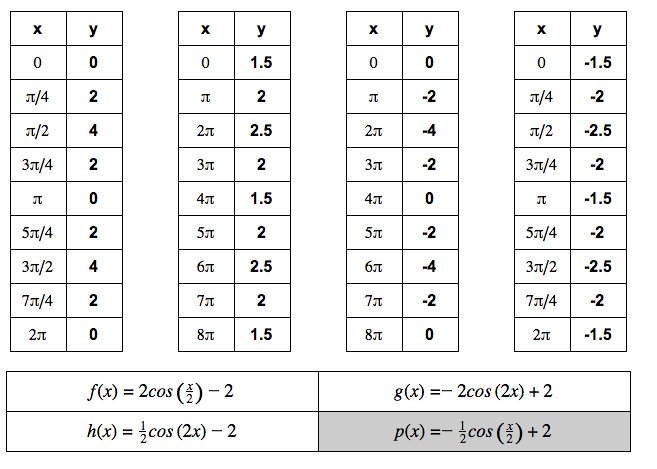Evidence of Understanding
- interpret the features of a trig function from its graph, table, or equation
- graph f(x) = sinx and g(x) = cosx and describe the relationship between inputs and outputs
- given any input, use the graph to identify the output
- identify the period, amplitude, midline, and frequency for any trig function
- explain connections between the unit circle and sine, cosine, and tangent functions
- describe restrictions on the domain and range
- identify intervals that are increasing, decreasing, positive, and negative
- represent trigonometric functions in multiple formats, including graphically, in table form, and as a function rule
- graph f(x) = sinx and g(x) = cosx and describe the relationship between inputs and outputs
- describe trig functions in relation to its parent function, f(x) = sinx, cosx, or tanx
- given the parent graph and another trig graph, describe how a transformation on the parent function impacts the function’s amplitude, midline, period and/or frequency
- create a graph, table of values, or equation for a function from a stated transformation
- write the function rule from the graph
- possible extension: explore parent functions of f(x) = cscx, secx, or cotx and create a graph, table of values, or equation for a function from a stated transformation
- use trigonometric functions to model different contexts
- solve a real-world situation by creating and using a trigonometric function rule, graph, or table
- analyze values to justify a trigonometric function model (and not linear, quadratic, or exponential)
- interpret solutions using trigonometric function models
- accept and reject possible solutions based on the context of the situation and the limitations on reasonable domain and range values
- solve a real-world situation by creating and using a trigonometric function rule, graph, or table
Develop conceptual understanding:
frequencySupporting terms to communicate:
function, input, output, domain, range, angle, cosine, sine, tangent, unit circle, reference angle, period, amplitude, midline, undefined, asymptote, interval, parent function, transformation
